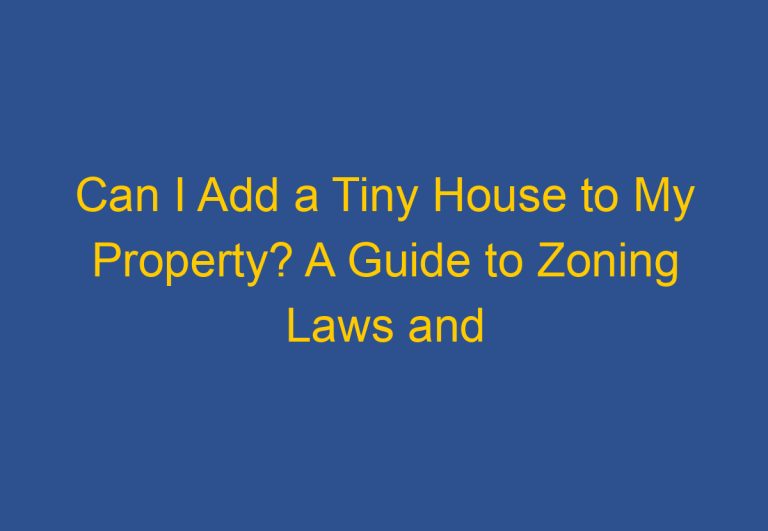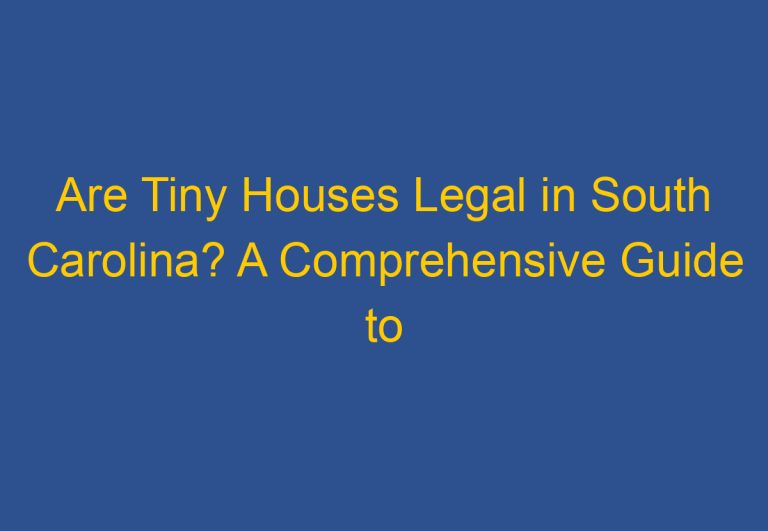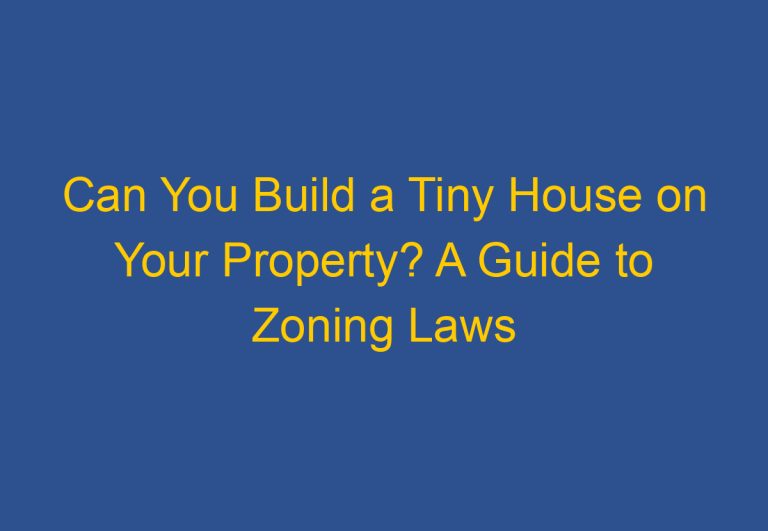Are Tiny Houses Legal in New Mexico? Exploring the State’s Building Codes and Zoning Laws
Tiny houses have become increasingly popular in recent years as a more affordable and sustainable housing option. However, many prospective tiny home owners are left wondering whether they are legal in their state. In the case of New Mexico, the answer is a resounding yes.
New Mexico has approved Appendix Q in the 2018 edition of the International Residential Code (IRC), which formally recognizes tiny homes as a legal housing option. This means that tiny homes are now recognized and regulated by the state building code, which defines a tiny house as a single-family home of 400 square feet or less, excluding lofts. The code also relaxes some general standards for such homes, making it easier for individuals to build and live in tiny homes in New Mexico.
It is important to note that while tiny homes are legal in New Mexico, there may be additional zoning and building regulations that vary by county and city. Prospective tiny home owners should always research and consult with local authorities to ensure that they are in compliance with all relevant laws and regulations. Nonetheless, the state’s recognition of tiny homes as a legal housing option is a promising step forward for those seeking a more sustainable and affordable way of living in New Mexico.
Legality and Zoning Regulations
Statewide Building Codes and Appendix Q
In New Mexico, tiny houses are recognized as single-family, non-mobile buildings that are 400 square feet or less. The state has adopted the International Residential Code (IRC), which includes Appendix Q, specifying the size range for small dwellings between 120 and 400 square feet. Tiny houses built on a permanent foundation should comply with the New Mexico Building Residential Code, including Appendix Q. Some of the laws worth highlighting are that the ceiling height of a tiny house’s living area and hallways must be at least 6 feet 8 inches.
Zoning Laws and Tiny House Communities
Zoning ordinances vary from city to city and county to county in New Mexico. Some areas have embraced tiny houses, while others have not yet caught up with the trend. Albuquerque and Bernalillo County have zoning laws that allow for tiny homes on wheels on private property, as long as they are connected to utilities and meet certain safety standards. Santa Fe and Roswell also allow tiny houses on wheels, but they must be parked in designated RV parks.
Hidalgo County has a tiny home village called River Edge Tiny Home Village, which is a community of 12 tiny homes. The Caballos de las Estrellas Community in Santa Fe also has tiny homes that are used for affordable housing. Valverde Commons is another tiny house community in Taos that has been around for over a decade.
Certificates of Occupancy and Residential Requirements
In New Mexico, tiny houses must meet the same residential requirements as traditional homes. This means that they must have a certificate of occupancy, which is issued by the local building department. The certificate of occupancy ensures that the tiny house meets all building codes and safety standards. Additionally, tiny houses must have a permanent foundation and be connected to an approved onsite sewage system.
It is important to note that each city and county in New Mexico has its own zoning ordinances, building codes, and regulations regarding tiny houses. It is recommended to consult with local authorities and professionals before building or purchasing a tiny house in New Mexico.
Construction and Utilities
Building Standards for Tiny Houses
New Mexico has approved Appendix Q in the 2018 edition of the International Residential Code (IRC), which includes building standards for tiny houses. The IRC specifies that tiny houses must be classified as single-family, non-mobile buildings that are 400 square feet or less. Tiny houses must also comply with New Mexico building and construction codes. The design and construction of tiny houses must be in accordance with the New Mexico Residential Code, which includes requirements for loft guards, ceiling height, lighting, bathrooms, kitchens, hallways, egress roof access windows, and mechanical ventilation.
Water, Electricity, and Sanitation
Tiny houses must have access to water, electricity, and sanitation. The state requires that tiny houses be connected to an approved onsite sewage system. Tiny houses can also be connected to a public water system or a private well. Electricity can be provided by a utility company or generated by solar power. Rainwater collection is allowed in New Mexico, but it must be done in accordance with state and local regulations.
Sustainable Features and Off-Grid Living
New Mexico encourages sustainable living and off-grid living. Tiny houses can be designed to include sustainable features such as solar panels, rainwater collection systems, and composting toilets. Off-grid living is allowed in New Mexico, but it is important to ensure that the tiny house is designed and constructed to withstand wind and other weather conditions. Tiny houses on wheels must be properly secured to prevent movement during high winds.
In summary, New Mexico has approved building standards for tiny houses, including requirements for loft guards, ceiling height, lighting, bathrooms, kitchens, hallways, egress roof access windows, and mechanical ventilation. Tiny houses must have access to water, electricity, and sanitation and can include sustainable features such as solar panels, rainwater collection systems, and composting toilets. Off-grid living is allowed in New Mexico, but it is important to ensure that the tiny house is designed and constructed to withstand wind and other weather conditions.
Frequently Asked Questions
What are the zoning regulations for tiny houses in New Mexico?
Tiny houses are classified as single-family, non-mobile structures that are 400 square feet or less in New Mexico. These structures are accepted as a legitimate housing option and are subject to the state’s International Residential Code (IRC), Appendix Q. Zoning regulations vary by city and county, so it’s important to check with the local zoning authorities to ensure compliance.
Can I legally place a tiny home on a foundation in New Mexico?
Yes, tiny homes can be placed on a foundation in New Mexico. As long as the structure meets the state’s building codes and zoning regulations, it can be placed on a foundation and treated as a permanent structure.
Are there specific building codes for tiny homes in New Mexico?
Yes, New Mexico has adopted the International Residential Code (IRC), Appendix Q, which specifies the size range for small dwellings between 120 and 400 square feet. The IRC provides guidelines for the construction of tiny homes, including safety standards, plumbing, electrical, and mechanical systems.
Is it possible to live off-grid in a tiny house in New Mexico?
Yes, it’s possible to live off-grid in a tiny house in New Mexico. However, it’s important to ensure that the structure meets all building codes and zoning regulations before going off-grid. Additionally, some cities and counties may have specific regulations regarding off-grid living, so it’s important to check with the local authorities.
Do I need a permit to build a tiny house in Albuquerque?
Yes, a building permit is required to build a tiny house in Albuquerque. The permit process includes submitting plans and obtaining approvals from various departments, such as zoning, building safety, and environmental health. It’s important to follow the permit process to ensure compliance with all regulations.
What are the requirements for establishing a tiny home community in New Mexico?
The requirements for establishing a tiny home community in New Mexico vary by city and county. Some areas may require special permits or zoning changes, while others may have specific regulations for community living. It’s important to check with the local authorities to ensure compliance with all regulations before establishing a tiny home community.










